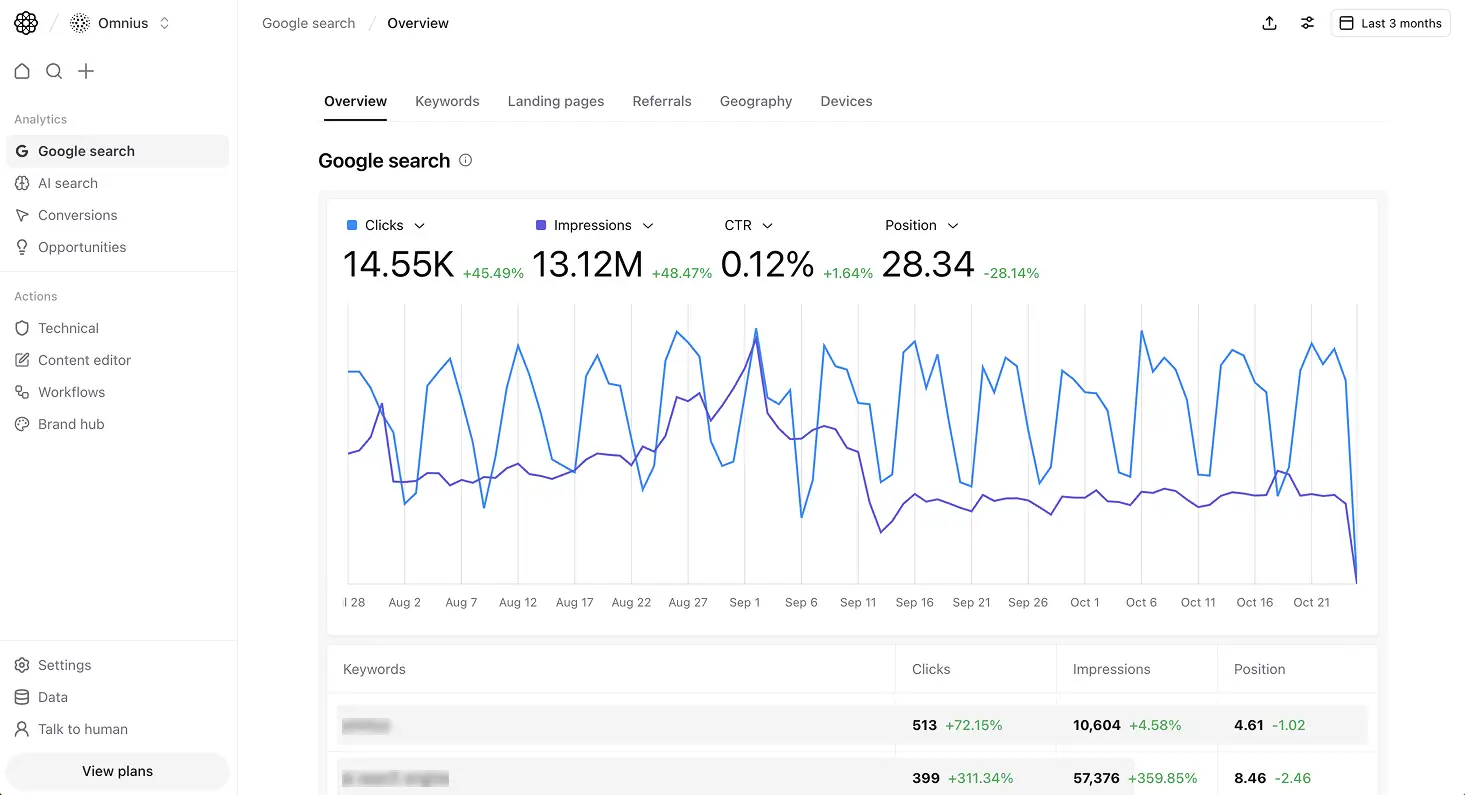






The Google Analytics module in AtomicAGI is designed to replace fragmented SEO data views with a verified, conversion-aware analysis layer. Traditional tools often show clicks, impressions, and positions without connecting them to meaningful outcomes. Atomic resolves this by integrating evidence-based GSC metrics with GA4 engagement and conversion signals, creating an actionable performance model for organic search.
Each dataset is reconciled at the page and query level, removing inconsistencies between GSC and GA4. This alignment ensures that metrics like clicks, CTR, and position accurately correspond to user behavior and conversion trends, not just visibility fluctuations.
The overview panel displays total clicks, impressions, CTR, and average position alongside historical trends. Atomic tracks deltas over time, identifying shifts in traffic quality or ranking distribution. For example, a rising impressions curve with flat clicks suggests a potential CTR decline, while concurrent position improvements often correlate with content or technical optimizations detected elsewhere in the platform.
Each dimension is navigable:
These dimensions can be filtered, sorted, and compared to reveal where search behavior or technical performance influences ranking trends.
All search data originates from Google Search Console’s verified dataset. Atomic performs reconciliation with GA4 pageview and event data to align search impressions and clicks with downstream activity. Any discrepancies between the two sources are processed through Atomic’s validation pipeline, which applies conflict resolution rules and flags anomalies.
This methodology ensures that reported metrics reflect actual evidence rather than API-snapshot discrepancies. Each chart and table in the module carries a confidence level, so teams know whether a metric represents direct measurement or modeled approximation.
Clicks represent confirmed interactions from Google’s search results to site pages.
Impressions indicate how often a page appeared for a tracked query.
CTR (Click-Through Rate) measures efficiency of snippet engagement, useful for diagnosing title or meta issues.
Position reflects the average ranking of a URL for its associated queries.
Monitoring these together enables users to correlate ranking movement with user intent and conversion quality. For example, if clicks increase while position remains stable, the improvement likely stems from enhanced snippets or brand familiarity. Conversely, declining CTR with stable impressions may highlight poor snippet performance or changing SERP layouts such as AI Overviews.
According to current industry data, Google’s organic CTR has declined by roughly 12% year-over-year as AI summaries and rich results reduce direct click share. Atomic’s evidence layer makes such behavior measurable and traceable per page or query.
This module is used to answer specific operational questions:
Analysts can drill from the Overview graph into Landing Pages or Geography to trace fluctuations to specific segments. Combined with Content Intelligence and SEO Audits, these findings often reveal actionable causes such as metadata gaps, content depth issues, or indexing constraints.
The result is a feedback system where technical signals, ranking data, and business metrics operate in one continuous flow.
Atomic’s Advanced Google SEO Analytics connects directly with:
This integration allows teams to move from diagnostics to remediation without exporting data or relying on separate dashboards.

All data is sourced directly from the verified Google Search Console and GA4 APIs. Metrics are reconciled at the page and query level to ensure evidence accuracy.
Search Console data is refreshed daily. GA4 metrics sync in near real time, and deltas are recalculated automatically.
They measure different events. GSC records search-driven clicks, while GA4 measures on-site sessions and conversions. Atomic reconciles these through its validation pipeline to align timelines and user behavior.
Position is the benchmark for visibility, but CTR contextualizes it. Tracking both reveals whether ranking improvements translate to engagement.
Geography data derives from GSC’s country reports. Device data combines GSC device segmentation with GA4 event tagging, ensuring both visibility and interaction are represented.
Yes. GA4 conversion events can be linked to URLs or keywords, allowing performance measurement by both ranking and outcome.
If discrepancies exceed set thresholds, the system flags them with confidence labels and explains whether they stem from sampling, API delay, or reporting latency.


Integrate your data sources with Atomic in as little as 5 minutes.

Integrate with Atomic, and get up & running in 5 minutes.

Your data is visible only to you. Our system is completely encrypted.